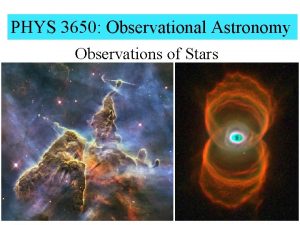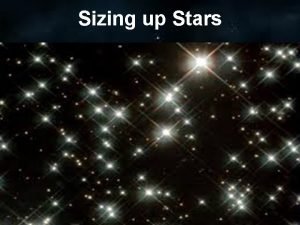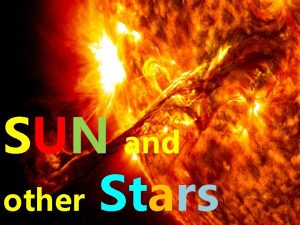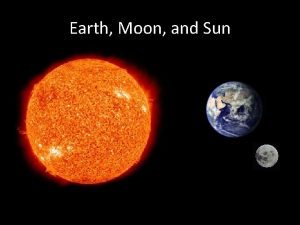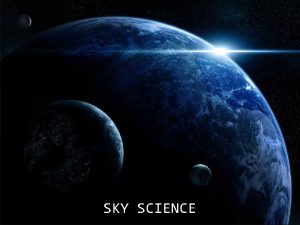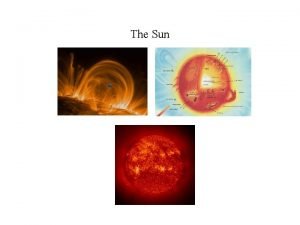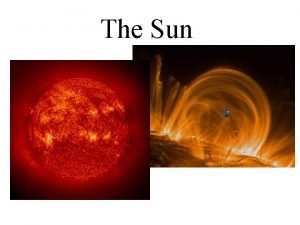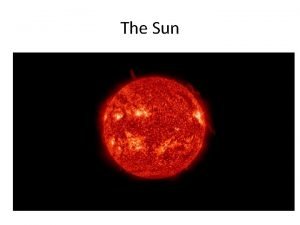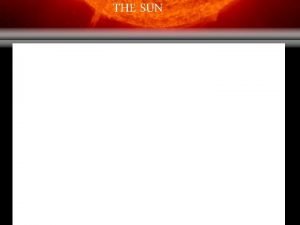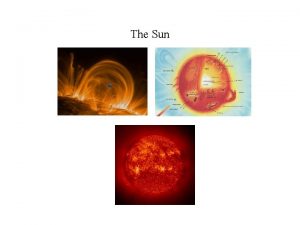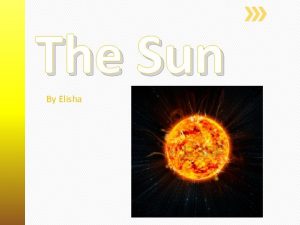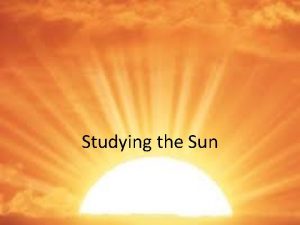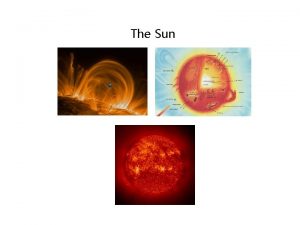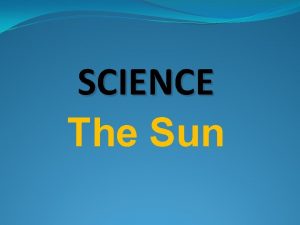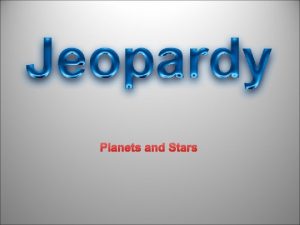The Sun and Other Stars How do stars



















- Slides: 19

The Sun and Other Stars • How do stars shine? • How are stars layered? • How does the Sun change over short periods of time? • How do scientists classify stars?

How Stars Shine • A star is a large ball of gas held together by gravity with a core so hot that nuclear fusion occurs. • Nuclear fusion occurs when the nuclei of several atoms combine into one larger nucleus.

How Stars Shine (cont. ) • Nuclear fusion releases a large amount of energy. • A star shines because when energy leaves a star’s core, it travels throughout the star and radiates into space.

Composition and Structure of Stars (cont. ) • There are three interior layers of a typical star. • When first formed, all stars fuse hydrogen into helium in their cores.

Composition and Structure of Stars (cont. ) • The radiative zone is a shell of cooler hydrogen around a star’s core. • In the convection zone, hot gases move toward the surface as cooler gases move down into the interior.

Composition and Structure of Stars (cont. ) Beyond the convection zone are three layers of a star’s atmosphere— the photosphere, the chromosphere, and the corona.

Composition and Structure of Stars (cont. ) The photosphere is the apparent surface of a star, where light energy radiates into space.

Composition and Structure of Stars (cont. ) • The chromosphere is the orange-red layer above the photosphere. • The corona is the wide, outermost layer of a star’s atmosphere.

Changing Features of the Sun: Sunspots • Cooler regions of magnetic activity • Seem to move as the Sun rotates • Number varies on an 11 year cycle Digital Vision/Punch. Stock

Changing Features of the Sun: Coronal Mass Ejections (CMEs) • Huge gas bubbles ejected from the corona • Larger than flares • May reach Earth • Can cause radio blackouts NASA

Changing Features of the Sun: Prominences and Flares • Prominences—clouds and jets of gases forming loops into the corona • Flares—sudden increases in brightness, often near sunspots or prominences SOHO Consortium, ESA, NASA

Changing Features of the Sun: The Solar Wind • Caused by charged particles streaming away from the Sun • Extends to the edge of the solar system • Causes auroras CORBIS

Groups of Stars • Most stars exist in star systems bound by gravity. • Many stars exist in large groupings called clusters. • Stars in a cluster all formed at about the same time and are the same distance from Earth.

Classifying Stars • Scientists classify stars according to their spectra. • Though there are exceptions, color in most stars is related to mass.

Blue-white stars tend to have the most mass, followed by white stars, yellow stars, orange stars, and red stars.

The Hertzsprung-Russell diagram is a graph that plots luminosity against temperature of stars.

The y-axis of the H-R diagram displays increasing luminosity and the x-axis displays decreasing temperature.

Most stars exist along the main sequence.

The mass of a main-sequence star determines both its temperature and its luminosity
 How big is the sun compared to other stars
How big is the sun compared to other stars There are millions of stars in
There are millions of stars in Sun is a star
Sun is a star Self-initiated other-repair
Self-initiated other-repair Hát kết hợp bộ gõ cơ thể
Hát kết hợp bộ gõ cơ thể Bổ thể
Bổ thể Tỉ lệ cơ thể trẻ em
Tỉ lệ cơ thể trẻ em Voi kéo gỗ như thế nào
Voi kéo gỗ như thế nào Chụp tư thế worms-breton
Chụp tư thế worms-breton Alleluia hat len nguoi oi
Alleluia hat len nguoi oi Các môn thể thao bắt đầu bằng tiếng bóng
Các môn thể thao bắt đầu bằng tiếng bóng Thế nào là hệ số cao nhất
Thế nào là hệ số cao nhất Các châu lục và đại dương trên thế giới
Các châu lục và đại dương trên thế giới Công thức tính thế năng
Công thức tính thế năng Trời xanh đây là của chúng ta thể thơ
Trời xanh đây là của chúng ta thể thơ Cách giải mật thư tọa độ
Cách giải mật thư tọa độ Làm thế nào để 102-1=99
Làm thế nào để 102-1=99 độ dài liên kết
độ dài liên kết Các châu lục và đại dương trên thế giới
Các châu lục và đại dương trên thế giới
